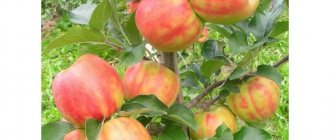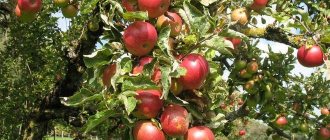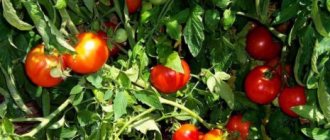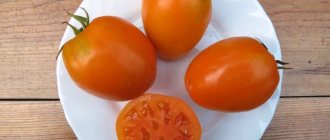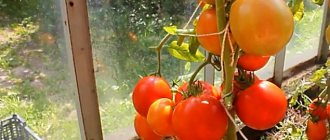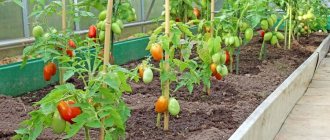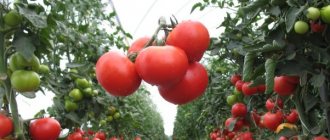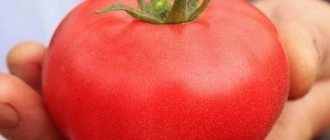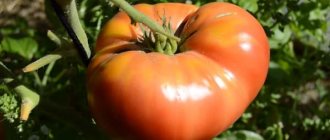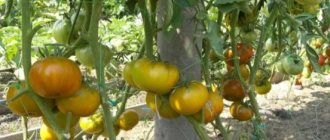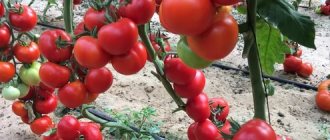Many gardeners planning to purchase fruit tree seedlings are interested in winter apple varieties that can be preserved until spring. They are the ones that fill store shelves and grace the tables of Russians throughout the cold season.
Among the winter varieties you can choose options for every taste
The modern assortment of apple trees that produce late fruits of very high quality is extremely wide. Most of them are able to please the summer resident with productivity, unpretentiousness and other excellent properties. We will talk about the variety and rules for choosing such plants in today’s article.
Apple tree carnival variety description. New apple varieties obtained from inclusion
It is very important that most of the apple trees created by Sergei Isaev are donors of valuable properties and are actively used in the creation of new generations of apple trees. The Northern Synapse has proven itself most well as the initial form. The designers of new “models of life” face a rather difficult task - to combine in the new genome the valuable advantages of the “king of Russian gardening” with the positive characteristics of the second parent, while separating part of the hereditary code with negative properties. In combinations with the Northern Synapse, this culling is primarily subject to the genetic information responsible for the growth power of the tree. The successors of Sergei Isaev's legacy managed to resolve this successfully in most cases.
For example, the new apple trees Aleksandrovskoye and Gorodishchenskoye, as well as the new elite form from the combination of crossing the Northern Sinap and Druzhba Narodov apple trees, have trees of weakened growth. They require significantly less manual labor to remove the woody part of the crown and significantly reduce the cost of labor when harvesting apples.
From the hybridization of the “king of Russian gardening” Northern Sinap with Martovsky, another new form was selected, combining the high productivity of Martovsky with increased resistance to unfavorable environmental conditions, for which Northern Sinap is especially famous. These apples have a beautiful appearance, as well as high taste and good keeping quality.
The apples of this new “life form” are somewhat larger compared to the Northern Sinap apples, their weight is at least 150 g, and in terms of ripening they are 10-15 days ahead of the ripening of the apples of the “king of Russian horticulture.” Thus, a new “form of life” can grow even in those areas where the apples of the Northern Synapse today do not have time to acquire either commercial advantages or a high level of quality of apple taste. A feature of this elite is the structure of the crown - the leaf surface and generative part of the crown are significantly strengthened, but the growth power of the tree is weakened.
From the synthesis of the hereditary structures of the Northern Synapse with the genome of the Dream apple tree, another new “pattern of life” was obtained with the name Gorodishchenskoe. This apple tree has high levels of genotype stability, early fruiting (the tree bears fruit already in the third year of life) and productivity. The apples have a very beautiful shape, have high taste qualities and, most importantly, they have very good transportability. Apples weigh 120-130 grams and can be consumed fresh for a long time. Apples can be consumed practically from August to December. Another very interesting fact is that inside the crown the apples do not acquire any outer color, that is, their skin remains white. It is these fruits that are stored for a particularly long time and have the ability to be consumed fresh for a long time. But the fruits formed on the illuminated side of the crown have a solid bright red color and have a very interesting taste, somewhat different from their white counterparts. The apple tree has a dense leafy crown with branches extending from the trunk at an angle of 60 degrees.
Selection of seedlings for a personal plot
Inexperienced gardeners are often of the opinion that any “late” apple tree is highly frost-resistant, and therefore will bear fruit well even in a region with fairly harsh and long winters. This is not so: both winter-hardy and more cold-sensitive varieties are known.
Winter hardiness and frost resistance of the plant do not depend on the timing of fruit ripening
There is one more problem: apples consumed in winter (especially late winter) take quite a long time to ripen and the short northern summer may simply not be enough for a full-fledged process. Therefore, for each variety there are recommendations for growing regions, and they must be taken into account when choosing a tree. There are other factors that determine the suitability of an apple tree for a particular cultivation location :
- depth of groundwater. Large trees planted in low, damp areas may suffer from waterlogged root systems. In such cases, you should choose seedlings formed on weakly growing rootstocks and having well-developed surface roots;
- the ability of the selected apple tree to set fruit on its own. Many varieties of the crop are completely or partially self-sterile. If there are no other trees near the garden with a similar flowering period, it is better to refrain from purchasing non-self-fertile seedlings;
- features of the processes of growth and “filling” of fruits. There are winter varieties of apples that are stored until spring, but are characterized by “unfriendly” ripening. The harvest from such trees has to be done selectively, in small portions. For summer residents who do not live on their plots permanently, this is not entirely convenient. In such a situation, apple trees that bear all the fruits at once are preferable;
- storage specifics. Apples of late varieties (“Jonathan”, “Idared”, “Gloucester”, etc.), even in cold storage, are often affected by “bitter pitting”. This applies primarily to large-fruited varieties. The problem can be solved to some extent with the help of competent agricultural technology. The fruits of the beloved “Antonovka vulgaris”, “Berkutovsky” and some other varieties develop a “tan” during storage (the skin becomes brown). This does not affect the taste of apples, but their appearance becomes less presentable.
For commercial cultivation, in addition to yield, the marketability and transportability of fruits are important
Our parents still remember those times when winter varieties of apple trees were very few. Over time, breeders' interest in developing varieties that produce fruits that can be stored for a long time and can easily be transported has increased. The reason was the need to establish industrial orchards that could satisfy the year-round demand for fresh fruit. At the same time, scientists sought to obtain apple trees that were highly resistant to diseases and not entirely favorable climatic conditions, which could be cultivated in central Russia. Today, late varieties are grown not only by large farms, but also by ordinary owners of personal plots almost throughout the country.
Apple tree flagship. Early varieties
It is generally accepted that early varieties of apples are those that ripen in midsummer. But, there are varieties that ripen at the beginning of the summer season. These fruits have a sour taste, but delight with their ripeness already in June or early July.
Early ripening ones include:
- White filling is very popular. Green apples with a yellow tint when fully ripe. A tree with a pyramidal crown bears fruit well. Originally from the Baltic states, it is resistant to cold and disease;
- Golden china is a drought-resistant species. The apple tree begins to bear fruit in the third year, producing fruit earlier than other early-ripening varieties. Sweet yellow apples do not last long, but they can be used to make jams and preserves;
- Moscow Grushovka is known in different regions of Russia. It is not whimsical and resistant to frost. Fragrant sweet and sour fruits ripen gradually. During long-term storage, apples lose their taste;
- Korobovka. A tall, frost-resistant apple tree with a spreading crown bears fruit of small size. Fragrant and sweet yellow-green apples are perfect for canning;
- Arkadik is a tall, powerful tree with a wide crown, very viable, and tolerates temperature changes well. Sweet and sour arcadicas have a spicy flavor;
- An early sweet variety characterized by flat fruits of light yellow color and sweet taste. The tree is low with a spreading crown and tolerates frost well;
- Super Prekos bears fruit for the first time in the fourth year. Precuts can be stored for a long time and tolerate transportation well. Sweet and juicy medium-sized apples.
Apple tree Children's. Description of the apple tree variety Children's
These relatively new apple trees are considered very promising, which is why interest in them is especially heightened. These are the very ones that are capable of ousting the good old varieties and taking their place.
These are unpretentious trees, resistant to severe frosts and their sudden changes, capable of withstanding harsh long winters and short hot periods of heat. At the same time, they are highly productive, the fruits are quite large, and their taste is unusually sweet. They are recommended for growing both in the courtyard of a private home and in intensive commercial areas.
Apples: what it looks like
The fruits predominantly grow to medium or slightly larger than average size, which is already a great achievement for Siberian apple trees. They grow approximately 95-150 grams in weight, one-dimensional and symmetrical, round or slightly flattened in shape with slightly pronounced ribbing.
The skin is dense, shiny, smooth and glossy, and has a fairly significant oily coating on it. When young it is deep green in color, but as it matures it turns yellowish-green. The integumentary blush is pale, occupies no more than 40-65% of the surface, soft pink or slightly reddish, blurry streaked, spotted, making the apples unsaturated variegated. Subcutaneous dots are numerous, medium in size, grayish-green, and not very visible on the surface. The chemical composition is as follows:
- P-active substances (catechins) – 326 milligrams.
- Ascorbic acid (vitamin C) – 8 milligrams.
- Total sugars (fructose) – 11.9%.
- Pectins (fiber) – 13.5%.
- Titratable acids – 0.15%.
The pulp is medium dense, slightly crunchy, tender, has a distinct creamy-green tint, and is very juicy. The taste is considered dessert, it is sweet, but has a slight sourness in the aftertaste. Professionals do not call it balanced and harmonious, although they classify it as pleasant. The tasting score is 4.4 points out of 5 possible.
Apple tree for children: characteristics
Crown and root system
It is customary to classify the variety as tall, but a more accurate definition is a medium-sized tree. The maximum height of the apple tree is approximately 4-4.5 meters, it does not grow any further, so the issue here is quite controversial. The crown of the tree is oval or pyramidal at a young age, but over the years it becomes broadly oval, spreading and even drooping. It can take up quite a lot of space, up to 5 meters in diameter, this should be remembered when planting. The branches are long, of medium thickness, covered with red-brown bark without pubescence.
The leaves are medium-sized, elongated, oval, long-pointed, deep green or simply green. They are leathery, dense, with rough nerves, finely grained, jagged, can be gathered in a boat, and have a wavy edge. The root system is highly branched, medium deep, and more often has a central core than does not have one.
Productivity and pollination
Compared to other Siberian and Ural apple trees, Detskoe can be called a high-yielding variety, although it certainly cannot catch up with Antonovka.
In one season, you can easily remove approximately 60-110 kilograms of aromatic sweet fruits from an adult trunk. The fertility rate is directly affected by weather and climate, as well as feeding and timely fertilizers.
The tree cannot pollinate on its own, so it needs other varieties of apple trees nearby that bloom at the same time. It is recommended to plant the variety interspersed with other autumn apple trees, so they can cross-pollinate each other. You can also spray the entire crown with diluted sugar during flowering and use the services of mobile apiaries.
Winter hardiness and disease resistance
The variety tolerates drops in ambient temperatures down to -38-40°C very well, so it can grow in fairly northern regions. If the climate is milder, and low rates usually do not last longer than 1-2 weeks, then you can limit yourself to simply wrapping the trunk with burlap, the tree will not be damaged. In other cases, it won't hurt to make efforts to provide better protection.
Average resistance to scab, various rots, powdery mildew and other fungal infections means you don’t have to worry too much about it. If you provide high-quality and timely prevention against fungi and insects, then trees will practically stop getting sick at all. During years of severe epiphytotics, the foliage of a tree may be damaged, but the fruits remain edible.
Rootstocks and subspecies
No subspecies of Children's have yet been bred, although it can be grown on a wide variety of rootstocks, which slightly changes the properties of the variety. For example, trees on dwarfs and semi-dwarfs are very compact and do not grow higher than 2-2.5 meters. True, their resistance to frost decreases, but the size of the fruit reaches 120-160 grams. On wildflowers and seed rootstocks, the tree becomes virtually invulnerable to frost, which allows it to be grown even in Siberia and the Far East.
Brief descriptions, characteristics and photos of popular varieties
"Idared" Vigorous, self-sterile apple tree; Fruiting is annual. Winter hardiness is high, resistance to fungal diseases is average. Under optimal storage conditions, the fruits do not lose their consumer properties for six months (until April-May).
"Idared" is recommended for cultivation in the North-Western (Kaliningrad region), North Caucasus and Lower Volga regions
“Alesya” The tree is small, the growth force of the crown is relatively weak, which makes it easier to care for and harvest. Resistance to freezing and fungal diseases is high, and resistance to drought is average. Fruiting is annual. Apples do not lose their consumer properties until the end of May.
“Alesya” is one of the most promising varieties of Belarusian selection
"Antey" Medium-sized, partially self-fertile. Fruiting is annual. Resistance to frost (in the conditions of the Moscow region) is high, to fungal diseases - average. Apples can be stored for 6-7 months (until the end of May).
“Antey” was bred by Belarusian specialists and entered into the State Register of the Russian Federation for the North-Western and Central regions
“Antonovka vulgaris” The apple tree is vigorous, self-sterile, and very productive. Fruiting is characterized by periodicity (fruitful years alternate with lean years). Winter hardiness is high, resistance to fungal diseases is average. When properly stored, apples retain their consumer properties until the end of December. The variety is valued for its unique sweet and sour taste of fruits, which, according to fans, has no analogues.
The famous “Antonovka” is an ancient, widespread variety of culture
“Bashkir winter” Tree is medium-sized, self-sterile. Resistant to scab, freezing and drought. Fruiting is annual and abundant. The shelf life of apples is more than 220 days (until the end of May).
“Bashkir winter” is cultivated in the forest-steppe and steppe horticultural zones of Bashkortostan; zoned in Tatarstan, Ulyanovsk, Orenburg and Samara regions
"Berkutovskoe" Medium vigor, self-sterile, very productive. Resistance to drought and freezing is high, to scab - average. In damp summers it can be affected by powdery mildew. Fruiting is annual. The fruits last until April.
"Berkutovskoe" is recommended for cultivation in the Lower Volga region
“Bogatyr” Tall, productive, self-sterile. Fruiting is annual. Winter hardiness and resistance to fungal diseases are average. Apples retain their consumer properties until mid-April - early May.
“Bogatyr” was bred by specialists from the All-Russian Research Institute of Genetics and Selection of Fruit Plants named after. I. V. Michurina
“Bratchud” (“Brother of the Wonderful ”) Dwarf apple tree (belongs to the group of “natural dwarfs of Mazunin”), winter-hardy, non-self-fertile. Resistance to fungal diseases is average. Fruiting is annual. The shelf life of apples is until the end of December.
The height of trees on seed rootstocks is up to 2.7 m, on clonal rootstocks (vegetatively propagated) - up to 1.5-2.0 m
“Currency” The tree is low-growing, with a columnar crown. Resistance to freezing is high, resistance to drought is average. There is a genetically determined immunity to scab. Partially self-fertile; Fruiting is annual. Apples are stored until mid-February.
Columnar “Currency” was included in the State Register of the Russian Federation in 2004, recommended for the Central region
“Cherry” Medium-sized, characterized by abundant, annual fruiting. Self-sterile, moderately resistant to unfavorable growing conditions and diseases. The fruit consumption period is until mid-February.
“Cherry” is very popular in Central Russia, zoned in the Central Black Earth Region and the Lower Volga region
"Gloucester" Tall, productive, partially self-fertile. Fruiting is strictly periodic. Winter hardiness is moderate (better suited for southern regions). Resistance to fruit rot and powdery mildew is high, and resistance to scab is average. The apples are large and very tasty. Stored until April.
"Gloucester" is one of the most popular commercial varieties of German selection in Europe
"Golden Delicious" The tree is medium-sized, self-sterile. Fruiting is annual and abundant. Resistance to unfavorable growing conditions and fungal diseases is below average. The fruits retain their consumer properties until April, but by the end of the storage period they are prone to wilting.
"Golden Delicious" in Russia is also known as the "Golden Excellent" apple-pear
“Star” Vigorous, scab-resistant. Winter hardiness is average, but after freezing the plant quickly recovers. The variety is self-sterile. Fruiting is annual. Apples can be stored until March.
“Zvezdochka” is widespread in many regions of Central Russia, in the State Register of the Russian Federation since 1972
“Amazing” The apple tree is medium-sized, self-sterile. Resistant to fungal diseases. Winter hardiness is average. Fruiting is annual and very abundant. The fruits are stored until March - April.
The variety is also known as “Rossoshanskoe delicious”, distributed in the southern regions of the Central Black Earth Region, Rostov region, and the North Caucasus
"Imant" Medium-sized, winter-hardy, immune to scab. Partially self-fertile, fruiting annually. The fruits are bright and large. Stored until May - June.
"Imant" is included in the registers of Belarus (recommended for all regions) and Russia (for the Central region)
"Imrus" The tree is medium-sized, with a compact crown. Winter hardiness is high, there is a genetically determined immunity to scab. The apple tree is partially self-fertile. Fruiting is annual and abundant. The fruits remain fresh until the end of February.
"Imrus" - created on the basis of "Antonovka" by VNIISPK specialists
“Kazanischenskoye” Medium-sized, partially self-fertile, high-yielding. Fruiting is annual. Winter hardiness and resistance to fungal diseases are above average. The apples are very large, with high taste. Shelf life - until mid-May. It is characterized by a rather long growing season, so in the northern regions the fruits may not ripen.
“Kazanishchenskoe” is considered the best late-winter selection apple variety of the Dagestan SOS of fruit crops
“Kandil Orlovsky” Medium-sized, resistant to frost, has immunity to scab. The tree is partially self-fertile, bears fruit annually, and yields are high. Apples are stored until mid-February.
“Kandil Orlovskiy” (selections from VNIISPK) is recommended for cultivation in the Central Black Earth Region and the North Caucasus
"Kuban spur" Low-growing variety with a compact crown. Resistance to freezing and drought in the conditions of southern Russia is high. Requires protection against fungal diseases. Self-sterile, bears fruit annually. The productivity is very high. The fruits retain their consumer properties until March.
An intensive variety, created by the North Caucasus Zonal Research Institute of Horticulture and Viticulture, popular in the southern regions of Russia and Ukraine
"Ligol" Medium-sized, large-fruited, high-yielding. Resistance to unfavorable growing conditions and fungal diseases is high. Self-sterile, fruiting in mature trees is periodic. The fruits are very large and have high taste. They can remain in cold storage until March.
“Ligol” of Polish origin, included in the State Register of the Russian Federation in 2022 as approved for cultivation in the Central Black Earth region
"Lobo" The tree is medium-sized, self-sterile. Winter hardiness is high, resistance to fungal diseases is low. Fruiting is very abundant, annual. The fruits are large and suitable for eating immediately after picking. Stored until February.
"Lobo" is a variety of Canadian origin, a descendant of the legendary "Mekintosh"
“Moscow later” Vigorous, self-sterile. Harvests are plentiful, but fruiting is periodic. Resistance to freezing and scab is high. The fruits are large and can last until the end of May.
“Moscow Later” was displayed at Moscow State University. M. V. Lomonosov, in the State Register of the Russian Federation since 2001
“Nymph” Medium-sized variety, resistant to powdery mildew and scab. Winter hardiness is average. Self-sterile. Fruiting is regular, yields are very high. The fruits are large. Stored until May - June.
“Nymph” is a late-winter apple tree, considered very promising for intensive short-cycle gardens in the southern regions of Russia
"Orlik" Apple tree is medium-sized, self-sterile. Resistance to freezing and scab is average. Fruiting is periodic and abundant. The fruits can be eaten immediately after picking. The harvest is stored until mid-February.
"Orlik" is recommended for cultivation in the northwestern and central regions of Russia
"Ostankino" Natural semi-dwarf with a columnar crown. Winter-hardy, highly resistant to scab. Can be severely affected by powdery mildew. Self-fertile, fruiting annually. Apples are medium and large, stored until mid-February.
“Ostankino” is one of the varieties of V.V. Kichina (VSTISP), in terms of winter hardiness it is not inferior to “Melba”
"Pepin saffron" Medium-sized, self-fertile. Winter hardiness and disease resistance are average. Fruiting is annual and very abundant. The fruits are medium-sized, tasty, aromatic. Can be stored until March.
“Pepin saffron” was created by I. V. Michurin at the beginning of the 20th century, distributed throughout almost the entire territory of Russia
“Peach” Tree of spur type, medium-sized. Resistance to fungal diseases and unfavorable growing conditions (in the southern regions) is high. The variety is self-sterile. Fruiting is very abundant and regular. The apples are large and stored until May–June.
“Peach” was created by breeders of the North Caucasus Zonal Research Institute of Horticulture and Viticulture
“Gift to Grafsky” Tall, productive, resistant to freezing and disease. Non-self-fertile, bears fruit annually. The apples are very large and of high consumer quality. Storage duration is until April – May.
“Gift to Grafsky” is popular among gardeners in the central regions, in particular the Moscow region
“President” The tree is medium-sized, with a columnar crown. Self-fertile, fruiting regularly. Resistance to freezing and disease is average. The apples are large and retain their consumer properties until the end of December.
“President” is one of the first domestic columnar varieties bred by VSTISP
"Red Delicious" Medium-growing, high-yielding variety. Resistance to freezing and drought is average (better suited for growing in southern regions). It is quite actively affected by scab. Self-fertility is partial, pollinating neighbors are required. With intensive agricultural technology, fruiting is regular. The fruits are large and beautiful. Consumer ripeness is reached by mid-December and stored until April.
"Red Delicious" is of American origin and is one of the leaders in the global apple market.
"Renet Simirenko" The tree is vigorous, self-sterile. Yields are, on average, high (there are fluctuations from year to year). Severely affected by fungal diseases (requires protection). Prone to freezing, but recovers quickly. Resistant to heat and drought. Large, green apples can last until June.
“Simirenko” is an ancient variety, well known to all gardeners in Russia and post-Soviet countries
“Rozhdestvenskoe” Apple tree is medium-sized, high-yielding, winter-hardy. Is immune to scab. Partially self-fertile. Fruiting is annual. The shelf life of the fruit is until the end of January.
“Rozhdestvenskoye” is a representative of the new generation of domestic selection (VNIISK)
“Northern Sinap” The tree is vigorous and winter-hardy. Resistance to fungal diseases and drought is average. Productivity is high, fruiting is periodic. Partially self-fertile. The apples are large, beautiful, and very tasty. They remain in cool storage until May.
“Northern Sinap” is cultivated in many Russian regions and was included in the State Register in 1959
"Sinap Orlovsky" Tall apple tree, self-sterile. Fruiting is regular, yields are high. Resistance to drought and fungal diseases is average, and resistance to freezing is high. The fruits retain their consumer properties until May.
“Sinap Orlovsky” was bred on the basis of “Northern Sinap” by specialists from the All-Russian Research Institute of Horticulture named after. I. V. Michurina
“Sokolovskoye” Low-growing variety (from Mazunin’s group of natural dwarfs). Self-sterile, fruiting is periodic. Winter hardiness and disease resistance are high. The shelf life of apples is until January.
"Sokolovskoe" even on seed rootstocks does not exceed 1.5-2 m in height, has a flat-horizontal crown
“Sun” The tree is low-growing, with a rounded crown. It has high winter hardiness and genetically determined immunity to scab. The variety is self-sterile and bears fruit annually. The fruits are large and stored until December.
“Sun” selection VNIISK is recommended for cultivation in the central regions of Russia
"Spartan" Medium-sized, resistant to fungal diseases. Winter hardiness is average. The tree is self-fertile, fruiting without sharp periodicity, yields are high. The apples are medium-sized, smooth, with a bright, red blush, very sweet. Can be stored until April.
“Spartan” was bred by Canadian breeders in 1926 and entered into the State Register of the Russian Federation in 1988.
“Uslada” Medium-sized apple tree, winter-hardy and drought-resistant. Scab is mildly affected. Self-sterile, high yield, fruiting annually. The fruits can remain in cold storage until May.
“Uslada” has been zoned and recommended for cultivation in the North-Western and Central regions of Russia
"Welsie" The tree is medium-sized, partially self-fertile. It has average winter hardiness, high resistance to powdery mildew, and genetically determined immunity to scab. Productivity is high, without sharp periodicity. The fruits are stored until January.
"Welsie" is one of the most famous and widespread early winter varieties with fruits of dessert taste.
"Florina" A medium-sized apple tree intended for cultivation in the southern regions. Resistance to freezing is weak. There is immunity to scab and very low susceptibility to powdery mildew. The tree tolerates heat and drought well. Partially self-fertile, fruiting periodic. Apples are valued for their excellent taste and very high shelf life (can be stored until June).
“Florina” is of French origin, included in the State Registers of Russia and Ukraine
"Fuji" Tall tree. Resistance to heat and drought is high, resistance to freezing and scab is average. Severely suffers from powdery mildew. Self-sterile, fruiting is periodic. The fruits are large and stored until May.
"Fuji" is a famous Japanese variety, popular all over the world and has many clonal varieties
"Honey Crisp" Medium-sized apple tree, winter-hardy, highly resistant to powdery mildew and scab. Self-sterile, fruiting is regular, yields are high. The apples are very large and remain fresh until May.
"Honey Crisp" is grown on an industrial scale in the USA and Canada; it will be included in the State Register of the Russian Federation in 2022
"Champion" Tree of moderate growth. It is immune to scab and is almost not affected by powdery mildew. Resistance to adverse conditions is weak. The variety is partially self-fertile. Fruiting is periodic and abundant. The fruits reach consumer ripeness by November and can be stored until May.
The Czech “Champion” is popular in many countries of Europe and the former Soviet Union
